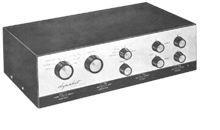 |
Dynaco PAS 2 stereo preamplifier |
|
The PAS2 stereo preamplifier arrived tor review in kit form. After a few initial difficulties I persuaded my 17-year-old son to build it. Although surrounded by 'hi-fi' he has no particular knowledge of it and no previous experience of constructional work. The instruction manual suggests that approximately 8 hours are required for building. It took my son 12 hours chiefly, I believe, because he was determined that there should be no errors. Both assembly and wiring proved simple enough, the latter because of the use of printed circuit boards. The front panel controls and switches account for most of the work to be done, but the diagrams in the manual are detailed so well that there is little possibility of error. In this case there was none as the unit worked first time and I think credit for this must be shared equally between Dynaco, for being so clear and thorough in their instructions, and my son for displaying a patience that I did not know he possessed. The PAS2 is a free-standing, self-powered twin channel preamplifier having enough inputs to satisfy the requirements of a research laboratory and features which are now be-coming familiar in American equipment. Thus we have separate treble and bass controls, a blend switch for reduction of the stereo effect and a loudness switch for low level listening. Each channel consists of two double triodes, the first stages being used for low level inputs and equalization and the second for high level inputs and tone control. Liberal use is made of negative feedback loops, over the first stage for RIAA compensation and to protect the input from overload, and over the second stage to provide the control circuits. A fixed tap on the volume control allows for the loudness compensation, which gives increased bass below 400 c/s at low-level settings. Although there are separate bass and treble controls for each channel the volume control is ganged and therefore common to both. The blend switch, in a succession of three steps, reduces a stereo input to mono in order, says the instruction book, "to eliminate any possibility of a hole in the middle which characterizes some types of stereophonic source material". While not wishing to comment on the pros and cons of this, which could well lead to lengthy argument, it is a feature which could prove very useful to those who listen to stereo with headphones to diminish what I would call the 'big-headed effect.' The scratch filter gives a rapid roll-off to frequencies above 7,000 c/s for noise reduction on gramophone records. A tape monitor switch is provided for tape recorders with monitor head so that A-B comparisons can be made, and a tape output socket connects to recorders not having this facility. The output of the preamplifier will suit any main amplifier having an input impedance of approximately 470 ohms. Modifications can easily be made, however, should different impedances be encountered. There are two rectifier systems, one for the normal HT supply and the other, a small selenium metal rectifier, for DC heater supply. Four AC outlets mounted on the rear panel, two switched and two unswitched, complete a stereo preamplifier that caters for all needs. Having tested the Mark IV power amplifier first I suppose that I should have been surprised if its companion had shown any deviations of note from the specification. In fact it did not, but I dislike dismissing in a single paragraph the result of many hours of measurement, yet in equipment that performs so well there is little to comment on! One of the outstanding features of this control unit is the low hum/noise figure - so low in fact that measurement is difficult, and instead of quoting figures I will misquote Rupert Brooke and say, "Noise will not weary them, nor the hum condemn". The range of tone controls measured - treble + 14dB to -16dB at 20 kc/s: bass +19dB to -18dB at 20 c/s. Frequency response measured at the radio input was within 1dB from 20 c/s to 40 kc/s, both channels. RIAA input (low level) was also within 1dB of the standard curve. When com-pared with British amplifiers, the one position scratch filter seems a little severe, producing a roll-off which is some 12dB down at 10 kc/s, but one must remember that it is labelled scratch and not simply filter. Listening tests (mono), using a low output magnetic pickup and the Mark IV power amplifier, revealed a smooth, pleasing quality that one only associates with expensive amplifiers and, of course, there is a large reserve of power under domestic conditions. This large power output prompted my son to test
it as a guitar amplifier and of course it takes this in its stride.
Beware of damage to loudspeakers when using it for this purpose!
For my part I tried the Mark IV power amplifier as a speech modulator
for amplitude modulation transmission. It is ideal for amplifying
a speech-clipping device as the phase shift is so low and it modulated
a radio frequency power of 100 watts with ease. Primarily, despite
other applications, the control unit and main amplifier constitute
an excellent high fidelity amplifier. Externally neat and tidy.
Internally not so neat and tidy. This combination must still take
its place among the very best. |
|||
 'The
'Gramophone' July 1963
'The
'Gramophone' July 1963